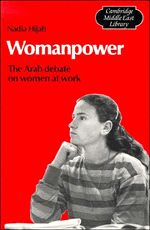Book contents
- Frontmatter
- Contents
- List of tables
- Preface
- List of abbreviations
- Introduction
- 1 The great family law debate
- 2 Cross-currents conservative and liberal
- 3 Arab women in the workforce
- 4 Jordanian women's liberating forces: inflation and labour migration
- 5 The Arab Gulf states: demand but no supply
- 6 Power past and future
- Bibliography
- Index
4 - Jordanian women's liberating forces: inflation and labour migration
Published online by Cambridge University Press: 01 June 2011
- Frontmatter
- Contents
- List of tables
- Preface
- List of abbreviations
- Introduction
- 1 The great family law debate
- 2 Cross-currents conservative and liberal
- 3 Arab women in the workforce
- 4 Jordanian women's liberating forces: inflation and labour migration
- 5 The Arab Gulf states: demand but no supply
- 6 Power past and future
- Bibliography
- Index
Summary
We need to broaden the base of our employment market by turning every available Jordanian into a skilled worker.
Jawad Anani, Minister of Labour in 1982In the previous discussion, the point was made that cultural tradition is not the main constraint on women's work for wages outside the home, and that attitudes change quite rapidly if the need and opportunity arise. Indeed, three conditions – need, opportunity and ability – must be met at the state and popular levels before women can be fully integrated into the workforce. Jordan makes an ideal case study to illustrate this argument further. It is a labour exporter, and the country's development process has suffered because of the loss of skilled manpower. It is also a labour importer that faces some of the same problems as the oil-rich, labour-importing Arab Gulf countries. Moreover, the Government has pursued policies favourable to women, particularly after the establishment of a woman-headed Ministry of Social Development in 1979. Finally, the country has been better able to provide social services than some other Arab states, and the people are quite highly skilled.
Need at the state level: from unemployment to labour shortage
Jordan's population was estimated at three million by the mid-1980s. Nearly two-thirds are Palestinians, whose forced dispersal from their homeland swelled Jordan's population in 1948 and again in 1967. In the mid-1980s, the main demographic problems were the high birth rate and the youth of the population – about 53 per cent were estimated to be below the age of 15.
- Type
- Chapter
- Information
- WomanpowerThe Arab Debate on Women at Work, pp. 94 - 115Publisher: Cambridge University PressPrint publication year: 1988

